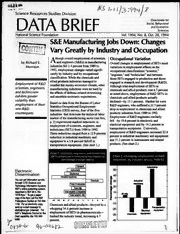
Data Brief... Vol. 1994, NO. 8... Science Resources Studies Division... National Science Foundation... October 28, 1994 PDF
Preview Data Brief... Vol. 1994, NO. 8... Science Resources Studies Division... National Science Foundation... October 28, 1994
AUOS§ Ns Ie 1/2:994] 8 rea * Science Resources Studies Division DATA BRIEF Directorate for Social, Behavioral and Economic Sciences National Science Foundation Vol. 1994, No. 8, Oct. 28, 1994 S&E Manufacturing Jobs Down: Changes Vary Greatly by Industry and Occupation Ithough overall employment of scientists Occupational Variation by Richard E. and engineers (S&Es) in manufacturing Overall changes in employment of SETs mask industries fell 2.4 percent from 1989 to Morrison variations in employment effects on the 1992, employment changes varied signifi- occupational classifications “scientist,” cantly by industry and by occupational “engineer,” and “technician” and between classification. While the chemicals and NE those SETs engaged in production and those allied products industries managed to engaged in research and development (R&D). Employment of R&D weather the stormy economic climate, other Although total employment of SETs in scientists, engineers, manufacturing industries were hit hard by chemicals and allicd products rose 6.7 percent and technicians the effects of defense-related downsizing as noted above, employment of R&D SETs in exhibits greater and uncertain economic expectations. chemicals and allied products actually volatility than declined—by 13.1 percent. Hardest hit were Based oa data from the Bureau of Labor employment of their R&D engineers, who suffered a 25.7-percent Statistics Occupational Employment non-R&D drop in employment in chemicals and allied Statistics (OES) survey, four of the five counterparts. products industries from 1989 to 1992. industries that dominate the technical labor Employment of R&D engineers similarly market of the manufacturing sector (see box, fell-- -by 19.6 percent in electronic and p. 2) experienced marked reductions in electrical equipment and by 14.2 percent in employment of scientists, engineers, and transportation equipment. Conversely, technicians (SETs) from 1989 to 1992. employment of R&D engineers increased 22.6 These reductions ranged from a 12.9-percent percent in industrial machinery and equipment reduction in industrial machinery and and 51.2 percent in instruments and related equipment to a 3.8-percent falloff in products. (See chart 2.) transportation equipment. (See chart 1.) Chart 1. Scientists, engineers, and technicians (boSm) E S Werl aavel(oh'zccemlamantclaleitcleacelalale mlale (0l-) (a( ose ‘Ofa t-1 a oom Oua t-lalelialem=iaalelio)aansial @elm at.4 ° elelgerstrealel (emolatelal(eo m bels iene V4 engineers. by industry group: 1989-92 Electronic | Dissemination [ industial machinery You can get information quickly Chemicals| through STIS (Science and (Total, 5 industies Technology Information System), | Total mig NSF's online publishing system, oal mep describedi nN SF 94-4, the “STIS flyer.” To get a paper Total empimt, mig | copy of the flyer, call the NSF Publications Section at 703-306- 12 70 8 7 6 3 4-1 > 4 6 1130. For an electronic copy, Chemicals and allied products—buoyed by a send an e-mail message to whopping 34.4-percent increase in [email protected] (Internet). For employment of SETs in pharmaceuticals— NSF's Telephonic Device for the Deaf capabilityd,ia l7 03-306- bucked the industry GtreOnd,n iIncPreaLsinEg T6.E7 D ie 0090 percent. OF94G& = Ao-OU6ZD Employment of R&D technicians fell Of the 20 major industry groups that the allied products—accounted for the* 18.9 percent in chemicals and allied manufacturing sector comprises, the following in 1992: 81 percent of SETs; 86 products, but R&D scientists fared five dominant industries—industrial percent of R&D SETs, 85 percent of somewhat better—their employment machinery and equipment, electronic engineers, 90 percent of engineers in dropped by only 4 percent. The data and other electrical equipment, instru- manufacturing R&D, and 88 percent of ments and related products, transporta- scientists in manufacturing R&D. (See suggest that R&D employment in the tion equipment, and chemicals and chart 3.) chemicals and allied products industries may be highly leveraged to Chart 3. Concentration of scientists. engineers. and the business cycle, given that (Tot alalloit- [arom wal caliam ance are lalene-(oacelaiaremialeler-ieater— employment of SETs not engaged in <YY> R&D increased by 19.1 percent, 12.8 percent, and 10.3 percent respectively. = hee Growth Industries “aes Certain manufacturing industries not only countered the generally down- ward trend in employment of SETs, but actually flourished. In addition to Technicians the increase in SET employment as described above in chemicals and allied products, increases in SET employment in other manufacturing industries ranged from 1.2 percent in .~ ~ rubber and miscellaneous plastics products to 8.1 percent in petroleum and coal products. Offsetting these gains were sizable decreases in WZ Industrial machinery fabricated metal products (10.1 ‘a Instruments percent), textile mill products (6.7 percent), and food and kindred prod- ucts (6.6 percent). The data presented in this Data Brief This Data Brief was prepared by Wilson Boulevard, Suite 965, Arlington, are being released in advance of the Richard E. Morrison, Senior Economist, VA 22230. For a free copy, write to the comprehensive Detailed Statistical National Science Foundation, Division above address, call 703-306-1773, or Tables report Scientists, Engineers, of Science Resources Studies, 4201 send e-mail to [email protected]. and Technicians in Manufacturing Industries: 1992. NATIONAL SCIENCE FOUNDATION ARLINGTON, VA 22230 OFFICIAL BUSINESS PENALTY FOR PRIVATE USE $300 RETURN THIS COVER SHEET TO ROOM P35 IF YOU DO NOT WITSO REHCEI VE THIS MATERIAL , OR IF CHAONF GADDERES S IS NEEDED (0 _, INDICATE CHANGE INCLUDING ZIP CODE ON THE LABEL (DO NOT REMOVE LABEL). NSF 94-326
